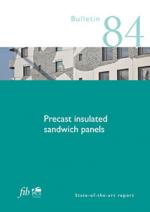fib Bulletin 84. Precast Insulated Sandwich Panels
- Citation:
- fib Bulletin 84. Precast Insulated Sandwich Panels, Hughes, Simon, Acker Arnold Van, Chastre Carlos, Gasperi Antonello, Jones George, Karutz Holger, Krohn Jason, Laliberté Diane, Lindstrom Gosta, Ronchetti Alessandra, Sennour Larbi, Seshappa Venkatesh, Sthaladipti Saha, Suika Arto, Tillman Mathias, and Tsoukantas Spyros , fib Bulletin 84, Number fib Bulletin, Lausanne, (2017) copy at https://docentes.fct.unl.pt/cmcr/publications/fib-bulletin-84-precast-insulated-sandwich-panels

Abstract:
Precast concrete sandwich panels started being used as cladding for buildings, together with the rise of industrial prefabrication, during the mid-20th century. Since then, society and industry have become increasingly aware of energy efficiency in all fields, for both affordability and sustainability consciousness. As such, buildings have been subject to increasingly stringent requirements with the technology of sandwich panels kept continually at the forefront.
Nowadays, sandwich panels have reached the highest standards of functional performance as structural efficiency, flexibility in use, the speed as well as of aesthetic appeal. These combine in building construction with the well-known advantages of prefabrication; such as construction, quality consciousness, durability and sustainability. Sandwich panels have gained more and more important in their field, thus representing quite a significant application within the industry of prefabrication and an important share of the market.
The Commission ‘Prefabrication’ is keen to promote the development of all precast structural concrete products and to transfer the knowledge to practical design and construction. Now filling a strategic gap, by issuing this Guide to Good Practice, which includes design considerations, structural analysis, building physics, use of materials, manufacturing methods, equipment, field performance, and provides a comprehensive overview of the information currently available worldwide. The Commission is particularly proud that this document is a result of close cooperation with PCI and that it will be published by both fib and PCI. This cooperation started six years ago, first with comparing the different approaches to several issues, then progressively integrating up to producing common documents, like this one, that wasn’t yet treated in a specific Guide by either body.
Notes:
n/a
